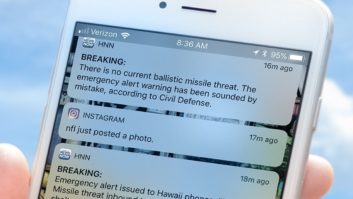‘What the Pueblo engineering team has done is to give total control of the programming and console functions to the person doing the remote.’
The engineering team in Pueblo, Colo., for Clear Channel stations KGHF(AM), KCSJ(AM), KJQY(FM) and KDZA(FM) is taking mobile remotes to the next level by using the latest wireless technology.
To date, the cluster is the only radio group of any owner in the western region using wireless for total multiple-station control from a remote location. We may be the only stations going this far with wireless radio remotes in the country.
The first major test was at the Colorado State Fair in Pueblo last summer.
Truly ‘remote’ control
Normally, remotes are accomplished by using a radio link from the remote van back to the station. Only audio can be remotely controlled. Usually, there is a console board operator at the station controlling the functions, such as breaks and line caller interaction, etc. The on-air talent at the remote has no control over the automated programming.
What the Pueblo engineering team has done is to give total control of the programming and console functions to the person doing the remote. The on-air talent can interact with his line audience and take total control of the station remote.
With the wireless mic and wireless laptop, they can take song requests and insert them immediately into the programming computer at the station. Live interviews and interaction with the remote audience are immediate. The audio portion of the remote is still done through the use of radio equipment at the remote van. Pueblo Engineering is working to eliminate this link.
The wireless link is achieved by first allowing engineering a connection to the Internet from our remote location. From there, we can Virtual Private Network to our main office and directly control our Prophet Systems Innovations automation system. Fortunately, our company already had an existing secure VPN infrastructure that we could utilize.
We are using existing technology to add another connection to this wireless ISP so that we make it a totally portable solution. A Linksys WRT54G wireless router is used to connect to the wireless broadband receiver to give us additional distance from where we actually have to set up the line-of-sight antenna.
Occasionally, we cannot get a LOS shot from inside a building, so it is necessary to move the antenna outside on a Will-Burt Hurry-Up mast. The wireless router then is connected; it will give us approximately 50 to 100 yards of mobility to use a laptop or pocket PC. No phone line is needed unless you need to have a backup control method. Unfortunately, a cell phone data connection is too slow to maintain effective control connectivity.
One of the main reasons many people are not going totally wireless is security issues with WiFi. We do not use the default setting in our wireless products. We also use MAC address filtering so that only the computers we authorize can get access to the system.
Even though the system is not bulletproof, the advantages outweigh the disadvantages enough to test the waters of this incredible technology. The wireless system has allowed the Pueblo cluster to eliminate the need for part-time console operators. The exceptions are local high-school games and some live sports events such as Colorado Rockies games where overtime cannot be predicted.
Just getting started
The current wireless infrastructure is being provided by AcuLink in Pueblo. Line-of-sight wireless equipment is being used. This situation has caused some problems with the existing Pueblo terrain. However, the technology and equipment is available to eliminate these problems and we are pursuing this equipment.
The wireless remotes have not been without failure at this point; but each remote has more than one backup piece of equipment in the event of a wireless failure. Our backup equipment in each case has allowed the on-air talent to complete the remote successfully.
Wireless remotes are still in their infancy. But the engineering team in Pueblo feels that we will be able to eliminate the old technology soon.












